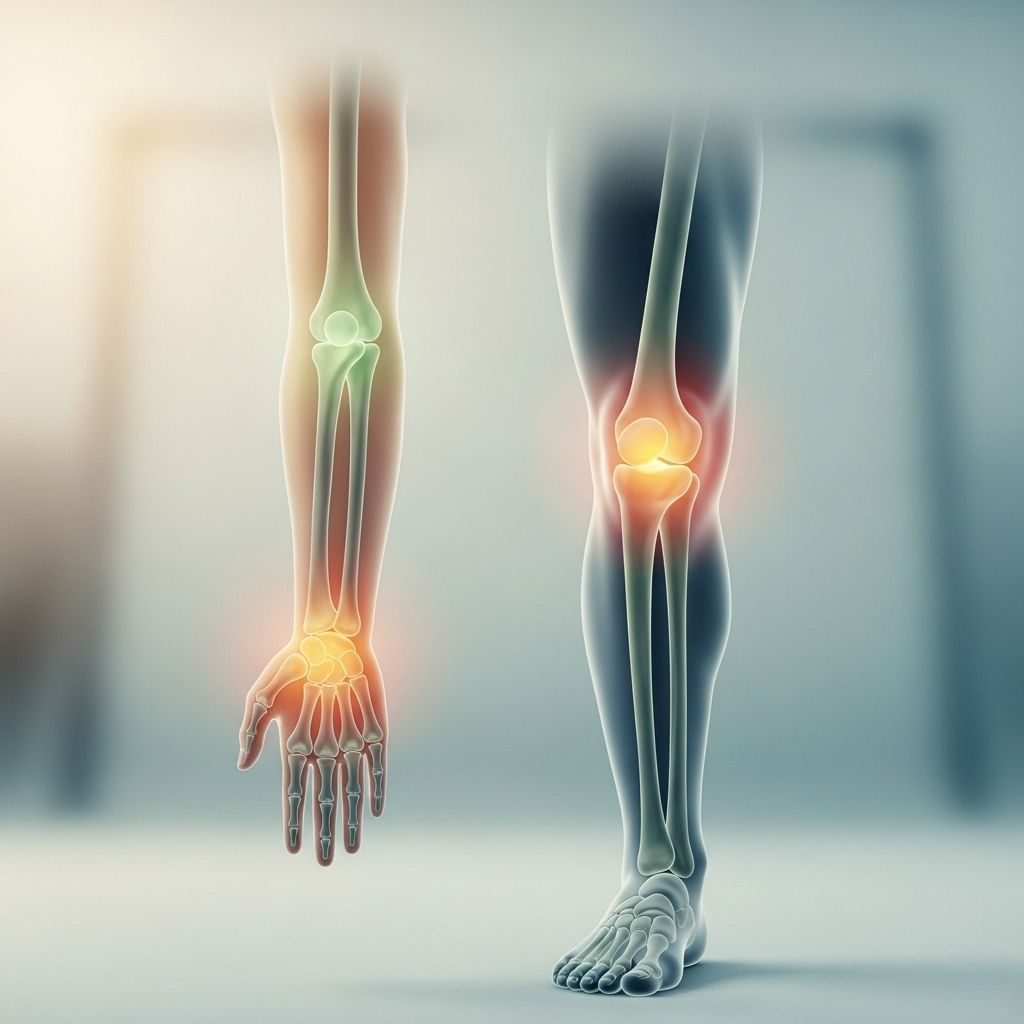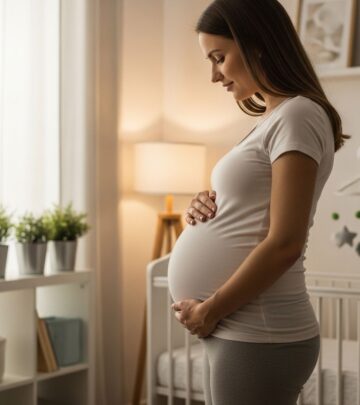Understanding Arthrogryposis: Causes, Symptoms, Diagnosis and Treatment
Arthrogryposis is a rare congenital condition that results in multiple joint contractures and muscle weakness. Learn about its causes, symptoms, diagnosis, and management options.

Arthrogryposis: Overview
Arthrogryposis, also known as arthrogryposis multiplex congenita (AMC), refers to a group of rare congenital (present at birth) disorders characterized by multiple joint contractures and muscle weakness, affecting two or more areas of the body. Joint contractures involve the abnormal fixation of joints in straightened or bent positions, greatly limiting mobility and function. Although most commonly involving the arms and legs, arthrogryposis can, in severe cases, affect nearly all joints, including the back and jaw.
Key Facts
- AMC is non-progressive, meaning it does not typically worsen over time but requires early intervention.
- The term describes over 400 distinct conditions sharing joint contractures as a central feature.
- Incidence is approximately 1 in 3,000 live births; amyoplasia, the commonest type, occurs in 1 in 10,000 births.
- Both genders are affected; in X-linked genetic forms, males are more commonly impacted.
What is Arthrogryposis?
Arthrogryposis is a descriptive term, not a specific diagnosis. It indicates multiple congenital contractures resulting in restricted joint movement and, frequently, muscle underdevelopment. While the most frequent presentation includes contractures of fingers, hands, wrists, elbows, shoulders, hips, feet, and knees, severe forms may involve nearly every joint in the body. The term itself derives from Greek words meaning curved or hooked joints.
Types of Arthrogryposis
- Amyoplasia: The most common type, involving significant underdevelopment of muscles and contractures in both arms and legs. Limbs may appear tubular, with soft, doughy feel.
- Classic Arthrogryposis: Often severe, impacting almost every joint including shoulders, elbows, wrists, hips, knees, hands, feet, and, less commonly, jaw and spine.
- Distal Arthrogryposis (DA): Primarily affects distal (far end) joints such as hands and feet, often with milder limitation of motion compared to other forms.
- Syndromic Arthrogryposis: Associated with abnormalities of other body systems (e.g., internal organs, nervous system), potentially causing additional concerns like intellectual disability, feeding or breathing difficulties, or delayed milestones.
Causes of Arthrogryposis
The underlying causes of arthrogryposis are complex and varied, generally falling into three categories:
- Genetic factors: Inherited mutations affecting muscle development, joint formation, or nerve function contribute to many cases. Some forms are related to known genetic syndromes or patterns (e.g., X-linked recessive disorders).
- Environmental factors: Maternal illnesses (such as diabetes), intrauterine infections, or exposure to certain drugs may limit fetal movement, contributing to joint contractures.
- Fetal development abnormalities: Most contractures develop during gestation when restricted fetal movement leads to abnormal joint positioning and underdeveloped muscles.
More than 150 genetic syndromes involve arthrogryposis as a feature. It is important to recognize AMC as a symptom complex, not a singular disease. In many cases, the precise cause is unknown.
Signs and Symptoms
The core symptom of arthrogryposis is joint contracture—stiffness that limits or virtually eliminates movement at affected joints. Contractures are permanent fixations, and muscles surrounding these joints are often weak, thin, or absent due to lack of use during development.
- Limited or absent movement in major joints (particularly arms and legs)
- Webbing of skin over joints (soft tissue webbing)
- Mild facial differences and sometimes jaw contractures, affecting feeding or speech
- Underdeveloped muscles, yielding tubular or cylindrical limb appearance
- Thin or fragile long bones in arms and legs
- Spinal deformities may develop over time or be present at birth
- One-third of cases involve central nervous system problems
- Additional findings can include cleft palate and, in males, undescended testes
Severity and specific manifestations depend on the underlying diagnosis. Sensation is usually preserved, and many individuals have normal intelligence unless the central nervous system is affected.
Diagnosis of Arthrogryposis
Arthrogryposis is detectable at birth or, sometimes, during pregnancy via ultrasound imaging. Diagnosis involves clinical examination, family medical history, and may include genetic testing or imaging studies to clarify the cause or degree of involvement.
- Physical Examination: Assessment of affected joints, muscle tone, and overall limb function.
- Prenatal Detection: Ultrasound may reveal decreased fetal movement or abnormal joint postures.
- Genetic Testing: Useful for identifying syndromic or inherited forms.
- Imaging (X-ray, MRI): To assess bone structure, joint position, and other system involvement.
Diagnosis is crucial for planning treatment and offering prognosis advice to families.
Prognosis
Most individuals with arthrogryposis enjoy normal life expectancy, especially when major internal organs are unaffected. Cognitive development is generally normal; speech, learning, and intellectual abilities remain intact, except where central nervous system involvement is present. With early and vigorous therapy, supportive care, and sometimes surgery, affected children frequently achieve independence and active lifestyles.
| Feature | Common Outcome |
|---|---|
| Intellectual ability | Normal (except cases with brain involvement) |
| Physical activity | Restricted but improvable with therapy |
| Life span | Normal unless associated malformations present |
| Independence | Often achievable with effective intervention |
Treatment Options for Arthrogryposis
Arthrogryposis treatment focuses on maximizing functional independence, improving joint mobility, and preventing complications. Approaches typically include:
- Physical therapy: Intensive therapy starting shortly after birth helps maintain and improve range of motion, strengthen muscles, and encourage normal development.
- Occupational therapy: Targeted exercises and activities to foster skills needed for daily living, such as grasping objects, dressing, and feeding.
- Orthopedic interventions: Bracing, casts, and splints can help maintain positions, correct deformities, and support movement.
- Surgical procedures: Where necessary, surgery can release contractures, lengthen muscles or tendons, repair dislocated joints, and address specific deformities (such as clubfoot).
- Assistive devices: Wheelchairs, walkers, adapted utensils, and other aids enhance mobility and independence.
A multidisciplinary care team—made up of pediatricians, orthopedic surgeons, physiatrists, therapists, and sometimes geneticists—works together to individualize management for each patient.
Living with Arthrogryposis
Most children with AMC can thrive and lead independent, productive lives, given proper care and support. Adapting to challenges and learning new skills, rather than overcoming them, is often the reality. Support groups, counseling, and educational resources can help families navigate day-to-day obstacles.
Notable Individuals with Arthrogryposis
- Marty Sheedy: Advocate and motivational speaker.
- Lee Pearson: British 11-time Paralympic gold medal-winning dressage rider.
- Mike Begum: Competitive video game player.
- Sunny Taylor: Painter and activist.
- Nicholas Taylor: U.S. Paralympic quad tennis champion.
- Luca “LazyLegz” Patuelli: B-boy dancer seen on international TV.
- Prudence Mabhena: Lead singer of the band “Liyana.”
Their achievements demonstrate that AMC does not preclude a fulfilling and successful life.
Frequently Asked Questions (FAQs) about Arthrogryposis
Q1: Is arthrogryposis a progressive condition?
A: No. Arthrogryposis is non-progressive, meaning new joints do not develop contractures as the person grows. However, joint mobility may change due to growth, development, and management.
Q2: Can arthrogryposis be detected before birth?
A: Yes, decreased fetal movement or abnormal joint positions can sometimes be seen on prenatal ultrasound. However, a definitive diagnosis may require postnatal examination.
Q3: Does having arthrogryposis mean my child will have intellectual disabilities?
A: Most children with AMC have normal intellect. Cognitive delays occur only if the central nervous system is involved, which is the minority.
Q4: What causes joint contractures in arthrogryposis?
A: The root cause is restricted fetal movement, which can result from genetic mutations, maternal health issues, or environmental exposures, leading to abnormal development of joints and muscles.
Q5: What are the treatment options available?
A: Treatment is individualized and usually involves physical and occupational therapy, bracing, surgery for severe contractures, and assistive devices to maximize independence and function.
Summary Table: Arthrogryposis Key Points
| Aspect | Description |
|---|---|
| Definition | Congenital condition(s) involving 2+ joint contractures and muscle weakness |
| Types | Amyoplasia, classic, distal, syndromic |
| Causes | Genetic, environmental, developmental |
| Diagnosis | Clinical examination, imaging, genetic testing |
| Symptoms | Joint stiffness, underdeveloped muscles, contractures at birth |
| Prognosis | Often normal intellect and lifespan; independence achievable with care |
| Treatment | Therapy, surgery, assistive devices, team approach |
Conclusion
Arthrogryposis, a group of rare congenital disorders leading to multiple joint contractures and muscle weakness, poses unique challenges but does not limit the potential for a full and rewarding life. Early intervention, multidisciplinary care, and a focus on maximizing independence enable most affected individuals to thrive. Research and patient advocacy continue to improve outcomes, support families, and promote understanding of this complex condition.
References
- https://www.uncortho.net/arthrogryposis-orthopaedic-surgeons-chapel-hill-nc/
- https://www.nationwidechildrens.org/conditions/arthrogryposis
- https://rarediseases.org/rare-diseases/arthrogryposis-multiplex-congenita/
- https://www.seattlechildrens.org/conditions/arthrogryposis/
- https://paleyinstitute.org/arthrogryposis/
- https://pmc.ncbi.nlm.nih.gov/articles/PMC2698792/
- https://www.childrenshospital.org/conditions/arthrogryposis
Read full bio of Sneha Tete












